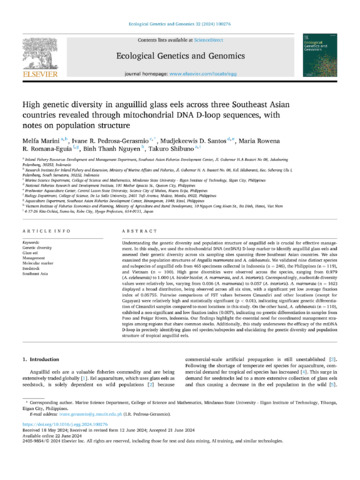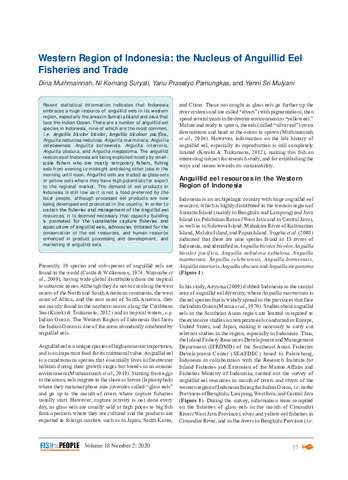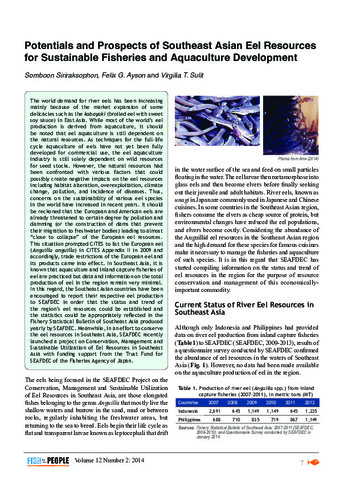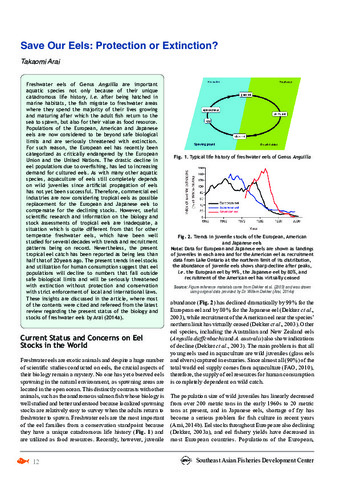High genetic diversity in anguillid glass eels across three Southeast Asian countries revealed through mitochondrial DNA D-loop sequences, with notes on population structure

閲覧/開く
Request this document日付
2024-09著者
Page views
426Metadata
アイテムの詳細レコードを表示するCited times in Scopus
Share
抄録
Understanding the genetic diversity and population structure of anguillid eels is crucial for effective management. In this study, we used the mitochondrial DNA (mtDNA) D-loop marker to identify anguillid glass eels and assessed their genetic diversity across six sampling sites spanning three Southeast Asian countries. We also examined the population structures of Anguilla marmorata and A. celebesensis. We validated nine distinct species and subspecies of anguillid eels from 465 specimens collected in Indonesia (n = 246), the Philippines (n = 119), and Vietnam (n = 100). High gene diversities were observed across the species, ranging from 0.979 (A. celebesensis) to 1.000 (A. bicolor bicolor, A. marmorata, and A. interioris). Correspondingly, nucleotide diversity values were relatively low, varying from 0.036 (A. marmorata) to 0.057 (A. interioris). A. marmorata (n = 162) displayed a broad distribution, being observed across all six sites, with a significant yet low average fixation index of 0.05755. Pairwise comparisons of FST values between Cimandiri and other locations (except for Cagayan) were relatively high and statistically significant (p < 0.01), indicating significant genetic differentiation of Cimandiri samples compared to most locations in this study. On the other hand, A. celebesensis (n = 110), exhibited a non-significant and low fixation index (0.007), indicating no genetic differentiation in samples from Poso and Poigar Rivers, Indonesia. Our findings highlight the essential need for coordinated management strategies among regions that share common stocks. Additionally, this study underscores the efficacy of the mtDNA D-loop in precisely identifying glass eel species/subspecies and elucidating the genetic diversity and population structure of tropical anguillid eels.
Suggested Citation
Marini, M., Pedrosa-Gerasmio, I. R., Santos, M., Romana-Eguia, M. R. R., Nguyen, B. T., & Shibuno, T. (2024). High genetic diversity in anguillid glass eels across three Southeast Asian countries revealed through mitochondrial DNA D-loop sequences, with notes on population structure. Ecological Genetics and Genomics , 32, 100276. https://doi.org/10.1016/j.egg.2024.100276
主題
Taxonomic term
Collections
- AQD Journal Articles [1241]
Related items
Showing items related by title, author, creator and subject.
-
Western Region of Indonesia: the Nucleus of Anguillid Eel Fisheries and Trade
Muthmainnah, Dina; Suryati, Ni Komang; Pamungkas, Yanu Prasetyo; Mulyani, Yenni Sri (Secretariat, Southeast Asian Fisheries Development Center, 2020)Recent statistical information indicates that Indonesia embraces a huge resource of anguillid eels in its western region, especially the areas in Sumatra Island and Java that face the Indian Ocean. There are a number of ... -
Potentials and prospects of Southeast Asian eel resources for sustainable fisheries and aquaculture development
Siriraksophon, Somboon; Ayson, Felix G.; Sulit, Virgilia T. (Secretariat, Southeast Asian Fisheries Development Center, 2014)The world demand for river eels has been increasing mainly because of the market expansion of some delicacies such as the kabayaki (broiled eel with sweet soy sauce) in East Asia. While most of the world’s eel production ... -
Save our eels: Protection or extinction?
Arai, Takaomi (Secretariat, Southeast Asian Fisheries Development Center, 2015)Freshwater eels of Genus Anguilla are important aquatic species not only because of their unique catadromous life history, i.e. after being hatched in marine habitats, the fish migrate to freshwater areas where they spend ...






